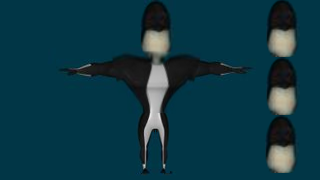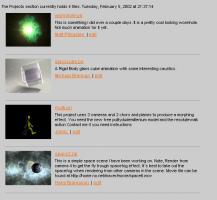-
Posts
21,630 -
Joined
-
Last visited
-
Days Won
114
Content Type
Profiles
Forums
Events
Everything posted by Rodney
-
As we are quickly running out of 2011 I'd like to make a suggestion.... Perhaps should we make this project the official 2012 Community Project? My thought is that this is obviously going to be a great project and we don't want to rush people by limiting them to the remaining three months in 2011. By slipping it to 2012 we'd also avoid the appearance that the project is running behind schedule every time someone sees the 2011 by-line. Perhaps more importantly as we move into 2012 this would allow everyone involved some quality time to spend with their animation. So what to do with the official 2011 Community Project designation? Should we just skip this year? I don't think so. Perhaps in the remaining three months we could collect some of the various short films, animation tests and imagery created with A:M as a look back at 2011 (and even back further as necessary). Something of an 'end of year' presentation... perhaps this could eventualy be an annual event? I don't think it'd be difficult to collect some great animation and imagery by the end of the year. As a side effect this might allow for two official community projects each year... a Community Project targeted for release in the summer and a recap/celebration at the end of the year. Just a thought.
-
Awesome. The way the eyelids are presently sticking outward makes it look a bit like he is wearing glasses. I'm not sure how you could reduce that effect without effecting the current style of eyes you have. If not rendering to toon, perhaps reducing the distance they stick out by about half would resolve that? As I've seen some of your other characters with similar traits I assume it's a specific style of eye you are going for so will leave it at that. If it works as is... it works.
-
Happy Birthday Rich! May this be just one outstanding birthday of many many more.
-
You can still use the old Cloth. We'd just need to adjust our frame of reference to assist you with it. You'll get a lot more bang for the buck out of the new SimCloth.
-
Here's an attempt to reimagine the character with roughly the girls proportions.... not sure if it's any improvement but hopefully you see what I mean by enlarging the head. I got a little carried away with reforming the chest and legs and actually prefer your broader legs over this one.
-
I really like this girl character! This character looks good but I think he could use some exaggeration in the right places to really finish him off. It might be good to see an image of their respective sizes to see how they play off of one another. My initial thought is that you could get away with bulking him up considerably more and enlarging the size of his head. For instance, the girl is approximately 3 heads tall whereas he is 4 and upwards to 5 heads. That gives the impression that they don't quite fit into the same world. Again, hard to say without a side to side comparison. I like them both.
-
I believe that is where this statement comes into play: Usually people don't think to use the Blur Post Effect along with the Softness settings. Not unlike Softening when used by itself, without Multipass rendering I find that Blur alone isn't very effective. They seem to need each other to pull off ideal blurring effects.
-
Since I see nowhere in your description where you say you've created a material I must assume you are not using SimCloth but are instead using the earlier version of Cloth that utilizes spring systems. We can troubleshoot the old Cloth but it might be better to tackle Simcloth. Download the zipfile at this link and you'll be on your way to SimCloth.
-
Yes indeedy. I did too.
-
Very Nice! Baldylocks too. Now that... is a scary... very interesting guy. Nice job on that model! An easy way to get that blade to lighten up a little would be to crank up the Ambiance Color and Intensity. (Assuming you don't add an environment map) I like it! But you know... in a later episode she should add some other cool parts... modular-like...all the latest and greatest on the market. You simply have to demo two handed gunsword mode... insanely humongous (but amazingly lite) ranger finder mode... You know... accessorize! I really like the rendering of Gwen. It has a calming effect and yet, I feel like I'm about to see her open a can of whoopass. (whatever that is) You are getting really good at this.
-
I'm trying to find a reference but haven't found it yet. It refers to some effects that don't kick in until 4x4 passes is set. I see a minor reference to that above but it isn't the quote I was after. But... that information is why I started to always use at least 4 passes set if I turn on Multipass.
-
Martin wrote this concerning Multipass (and pretty much any post effects added to a render during or after the rendering) and it's worth noting:
-
The Tech Reference should have a good write up (with pictures!) that states the following: There is more but this is from the 2003 write-up that tried to capture many of the benefits of Multipass rendering. The takeaway is that once you turn Multipass on there are quite a few things you can get in a rendering without it costing you more in time rendering frames.
-
Here is evidence of Gary mixing it up with some guy named JohnL... who was already a Tinkering Gnome way back when.
-
I think Gary Newby was the same guy that ran Amxchange.com back in the day. He also recreated the utility LibMaker (the first utility that created A:M Libraries by searching harddrives... not the later one by Rusty Williamson and Glen Anthofer) I exchanged an email with him back in 2005 wherein he stated: The rest of the email relates to my interest in the AMxchange URL. I have an email address for him if anyone is interested in contacting him. Since I don't know if he wants it published, please email me at: rodney.baker@gmail.com I've already launched an email toward Gary.
-
Please clue us in to how you perform that magic. (Sorry, I don't think I know the musician)
-
Awesome doesn't begin to describe you Marcos. Very innovative. Forgive me for a moment as I imagine how such things can augment our ability to analysis animation in A:M.
-
Bumping this up because one of Matt's commercials is now playing near the top of the forum.
-
Steve Sappington is the demonstrator for most of the TaoA:M videos. A couple years ago he traded in his demo hat for work in the medical field. He did teach computer animation from time to time at colleges in the Portland area. I'm not sure if he teaches there now as the last I had heard he had moved to Seattle. One of these days we'll have to corral him and convince him to create a new video tutorial. All of this mostly speculation. Several generations of animators have learned CG animation from Steve (I've got a secret. Can you keep a secret?) Sappington.
-
Aha! Holding out on us eh? You'll have a captive audience when you do get to the big reveal.
-
Look for the download link on the top right of the menu here: http://www.hash.com/amtutes/X_Vol001/Menu/html/Mach5.htm For those interested... with a little luck and a whole lot of work the next Extra DVD should have a menu similar to this.
-
I don't know where I was when this topic was posted but it sure wasn't here. Wow! You've done some great work with hair Mark. I so need to use some of this. Count me as one of those people, I sure didn't know that MatCap shaders could be used with hair. Thanks for bumping this up Tom! If my memory serves correctly Matt included it with the Mach V (Speed Racer) project so look for it in the project files on the Extra CD (not sure if it's on the Extra DVD but it should be).
-
I hear ya. Normally I would but I don't think I've actually used Sony Vegas. If I have used it, I would have to conclude that it didn't measure up to FCP and Premiere in my experience. Since it is so well considered I don't think I've yet tried it, therefore I cannot recommend it personally. FCP and Premiere I have used and can wholeheartedly recommend either. If/When I get a chance to try it out I will!
-
Need more Treeeeeeez! We love you for more than just your plugins. So come visit us more often. Happy Birthday Marcel!
-
You'll have to make a proxy model of yourself... you know.... for those long shot full figure effects. I don't want to scare you off but the episodic nature of Epic Gamin' might make it perfect as a Special Projects topic here in the A:M Forum. You are already leaning heavily into production and that might help to keep the A:M related aspects focused. Note that I am NOT suggesting Epic Gamin' itself move here. No way! BlipTV appears to be a perfect place for that. Maybe more of a "Making of Epic Gamin'" where others enjoy the show and regularly provide feedback. Of course we can do that just as well in this WIP thread too. No pressure. Something to think about. If the WIP ever gets too unwieldy it might give you some room to breath.











